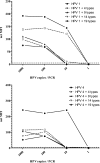Bead-based multiplex genotyping of 58 cutaneous human papillomavirus types
- PMID: 21832015
- PMCID: PMC3187343
- DOI: 10.1128/JCM.01173-11
Bead-based multiplex genotyping of 58 cutaneous human papillomavirus types
Abstract
Cutaneous human papillomaviruses (HPVs) are a heterogeneous, nonmonophyletic assembly, comprising about 50 characterized types and at least 133 isolates putatively representing new types. Their natural history of infection and potential association with nonmelanoma skin cancer are not well understood. Several PCR systems have been developed that amplify a broad spectrum of cutaneous HPVs. However, amplicon genotyping by sequencing or reverse line blot assays are complex and not well suited for high-throughput analyses. We developed a novel multiplex cutaneous papillomavirus genotyping (McPG) assay for 38 defined and 20 putative cutaneous HPVs of the beta, gamma, mu, and nu genera. Viral DNA was amplified by the use of a modified single-tube nested "hanging-droplet" FAP PCR. The amplifiable papillomavirus (PV) spectrum was enlarged by the use of 9 outer and 13 inner primers. Biotinylated PCR products were hybridized to type-specific oligonucleotide probes coupled to fluorescence-labeled polystyrene beads and analyzed using Luminex technology. Analytical sensitivity was analyzed for 38 defined HPVs and was ≤100 genome copies for all types. Integrated β-globin primers allow for simultaneous DNA quality control. McPG is characterized by high reproducibility (κ= 0.84, 95% confidence interval = 0.79 to 0.88), good concordance with the original nested FAP PCR, followed by sequencing (70.2% complete or partial agreement) when 322 skin biopsy DNA samples were analyzed, and improved ability to detect multiple infections (on average 2.5 HPV types per HPV-positive sample compared to 1.7 HPV types with nested FAP-PCR). In conclusion, McPG is a powerful tool for genotyping multiple cutaneous HPVs in a high-throughput format and is thus suitable for large-scale epidemiological studies.
Figures



Similar articles
-
Evaluation of a novel multiplex human papillomavirus (HPV) genotyping assay for HPV types in skin warts.J Clin Microbiol. 2011 Sep;49(9):3262-7. doi: 10.1128/JCM.00634-11. Epub 2011 Aug 3. J Clin Microbiol. 2011. PMID: 21813725 Free PMC article.
-
Evaluation of a novel broad-spectrum PCR-multiplex genotyping assay for identification of cutaneous wart-associated human papillomavirus types.J Clin Microbiol. 2010 May;48(5):1706-11. doi: 10.1128/JCM.02122-09. Epub 2010 Mar 17. J Clin Microbiol. 2010. PMID: 20237103 Free PMC article.
-
Detection and typing of cutaneous human papillomavirus types--a comparison of three different methods.J Virol Methods. 2013 May;189(2):305-10. doi: 10.1016/j.jviromet.2012.10.010. Epub 2012 Nov 2. J Virol Methods. 2013. PMID: 23124002
-
Molecular diagnosis of human papillomavirus (HPV) infections.J Clin Virol. 2005 Mar;32 Suppl 1:S43-51. doi: 10.1016/j.jcv.2004.12.004. J Clin Virol. 2005. PMID: 15753011 Review.
-
Beta Human Papillomavirus and Associated Diseases.Acta Cytol. 2019;63(2):100-108. doi: 10.1159/000492659. Epub 2019 Jan 23. Acta Cytol. 2019. PMID: 30673666 Review.
Cited by
-
Evaluation of a novel multiplex human papillomavirus (HPV) genotyping assay for HPV types in skin warts.J Clin Microbiol. 2011 Sep;49(9):3262-7. doi: 10.1128/JCM.00634-11. Epub 2011 Aug 3. J Clin Microbiol. 2011. PMID: 21813725 Free PMC article.
-
Characterization of type-specific HPV prevalence in a population of persistent cutaneous warts in Flanders, Belgium.Sci Rep. 2023 Oct 15;13(1):17492. doi: 10.1038/s41598-023-44154-y. Sci Rep. 2023. PMID: 37840107 Free PMC article. Clinical Trial.
-
Human papillomavirus in head and neck cancer.Cancers (Basel). 2014 Aug 18;6(3):1705-26. doi: 10.3390/cancers6031705. Cancers (Basel). 2014. PMID: 25256828 Free PMC article. Review.
-
Intralesional EBV-DNA load as marker of prognosis for nasopharyngeal cancer.Sci Rep. 2019 Oct 28;9(1):15432. doi: 10.1038/s41598-019-51767-9. Sci Rep. 2019. PMID: 31659192 Free PMC article.
-
Altered oral microbiome, but normal human papilloma virus prevalence in cartilage-hair hypoplasia patients.Orphanet J Rare Dis. 2024 Apr 18;19(1):169. doi: 10.1186/s13023-024-03164-3. Orphanet J Rare Dis. 2024. PMID: 38637854 Free PMC article.
References
-
- Akgul B., Cooke J. C., Storey A. 2006. HPV-associated skin disease. J. Pathol. 208:165–175 - PubMed
Publication types
MeSH terms
Substances
LinkOut - more resources
Full Text Sources
Research Materials
Miscellaneous

